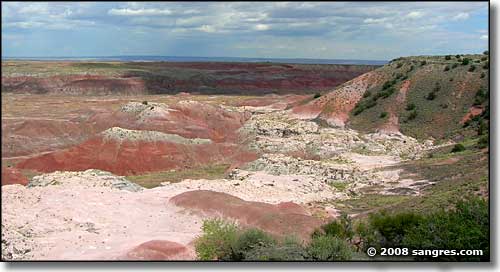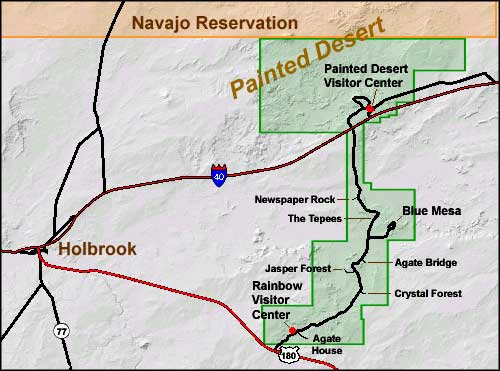
Petrified Forest National Park
The Painted Desert

The Painted Desert
Over the millenia, this landscape has been built up by layers of wind-blown sand, volcanic ash, ocean-bottom and lake-bottom sediment, and materials washed down from higher areas by rivers that ebbed and flowed across all those geological eras. This area is part of the southwestern region of the Colorado Plateau, a particularly thick and solid chunk of rock that has survived countless geological events over the last 2 billion years, yet remains virtually intact. The last great uplift of the Colorado Plateau occurred during the Laramide Orogeny, between 70 and 65 million years ago. There have been smaller uplifts since but the Laramide Orogeny pushed up a chunk of the Earth's crust reaching from Mexico to Canada. It was during the Laramide Orogeny that the Ancestral Rockies were formed. Then about 6 million years ago, the Gulf of California opened up to the southwest and the Colorado River began its famous erosive downcutting action to get there.
At the bottom of the Grand Canyon are the Vishnu Basement Rocks, solidified in place between 1,950- and 1,680-million years ago. More than a vertical mile above those rocks is the edge of the Painted Desert. The Painted Desert is a region of brightly-colored eroded and decayed mineral and organic materials that geologically lay above the rim of the Grand Canyon and below the Chinle Formation (a hard sandstone layer up to 1,800' thick). This zone is composed of sandstones, shales, mudstones and siltstones that have been exposed to the atmosphere as erosion of the region continues. The same forces that sculpted and shaped the Painted Desert have also exposed the petrified forest and continue to bring more and more of that ancient material to the surface. However, that petrified silica material is harder and heavier than the surrounding conglomerate deposits it is embedded in and as erosion continues, the matrix gets washed away and the silicates drop down onto materials that were in place long before those original forests grew. So as you walk out into the Painted Desert from the overlooks at Petrified Forest National Park, you'll pass by petrified trees that may be resting on top of fossilized seashells that are 2-to-3 times as ancient.
To go hiking here you'll want a compass and a good map: it's easy to get lost in this wild and colorful countryside. While hiking around you may come across ancient petroglyphs and stone houses that are up to 2,000 years old. There is no camping allowed in the Park but there is backcountry camping allowed in the Wilderness Area, just get a backcountry permit from the Visitor Center before they close for the day. The largest section of the Petrified Forest Wilderness extends northward into the Painted Desert until it comes up against the border with the Navajo Nation.

The Desert Inn, at the edge of the Painted Desert
To return, use the Back button in your browser.
 |
 |
 |
 |
 |
 |

